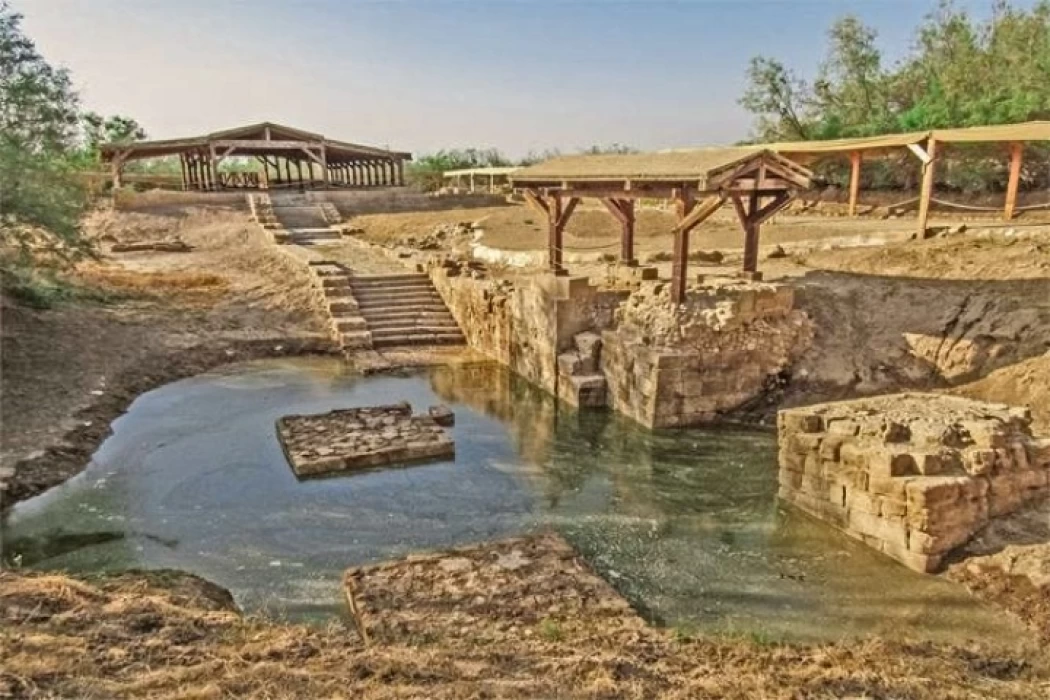
The Baptism Site of Jesus Christ
The site of the Baptism, or Al-Maghtas 'Bethany across the Jordan' as stated in the Gospel of St. John, is located on the eastern bank of the Jordan River, 9 km north of the Dead Sea, where John the Baptist used to call for repentance and was baptized there, including the baptism of Christ, as indicated by On it is the writings of Byzantine and medieval historians, as well as archaeological excavations. The World Heritage Committee of the United Nations Educational, Scientific and Cultural Organization “UNESCO” has included the baptism site of Jesus Christ “The Baptism” in Jordan, on the World Heritage List.
The baptism site includes two distinct areas:-
It has Tal al-Kharar, known as the hill of Mar Elias or the Prophet Elijah, where he moved from this area to heaven in a fiery chariot, as stated in the Bible. And secondly, the area of the churches of John the Baptist, near the Holy Jordan River. The place is characterized by churches, monasteries, caves, and Roman and Byzantine water pools, which were used by hermits at the time to grant baptism.
The site was reopened for pilgrims in the mid-1990s. Since most of the Christian churches in the world have adopted the Baptism site as the site of the baptism of Jesus, Jordan has agreed, since the beginning of the twenty-first century, to the request of these churches To build churches and pilgrimage houses for them in the place.
The Vatican had approved the Baptism Site as one of the approved Christian pilgrimage sites in Jordan in 2000, along with Mount Nebo, where the Prophet Moses saw the Holy Land. Jebel Mukawar, the site of the beheading of John the Baptist; The Church of Our Lady of the Mountain in the town of Anjara, which, according to tradition, Jesus and his mother passed through that town and rested in a cave in the Ajloun mountains; And the site of Mar Elias, the birthplace of the Old Testament prophet Elijah.
Latest Articles
Admin
Seabourn Sojourn Cruise Stops in Safaga Port
The Seabourn Sojourn, the flagship vessel of Seabourn Cruise Line's ultra-luxury fleet, was built in 2008 at the T. Mariotti shipyard in Genoa, Italy. Measuring 198 metres, it can accommodate up to 450 guests in its 225 spacious all-suite staterooms.
Admin
Norwegian Sky Cruise Stops in Safaga Port
Norwegian Cruise Line operates a cruise ship called the Norwegian Sky. It was constructed in 1999 and can accommodate 2,004 passengers in addition to 878 crew members. The ship has several dining establishments, lounges and bars, a spa and fitness center, swimming pools, and a number of entertainment areas.
Admin
Explora II Cruise Stops in Safaga Port
Explora II, the second vessel in the Explora Journeys fleet, sets sail in 2024 to redefine luxury cruising. With 461 ocean-front suites, 9 culinary experiences, and 4 pools, this haven of sophistication and sustainability promises an unforgettable "Ocean State of Mind" journey to inspiring destinations.
Admin
Mein Schiff 6 Cruise Stops in Safaga Port
The Mein Schiff 6 is the latest cruise ship in the renowned TUI Cruises fleet, offering passengers a luxurious and sophisticated cruise experience. At 315 metres long, this floating resort features a range of dining options, entertainment, and recreational facilities, including a spa, fitness centre, and sports amenities.
Admin
Mein Schiff 4 Cruise Stops in Safaga Port
When the Mein Schiff 4 cruise ship docks in Safaga, Egypt, passengers are granted access to a realm of ancient wonders. Aboard this state-of-the-art vessel, guests can embark on meticulously curated shore excursions that showcase the region's most iconic landmarks, including the Giza Pyramids, the enigmatic Sphinx, and the remarkable tombs and temples of the Valley of the Kings in Luxor.
Admin
MS Europa Cruise Stops in Safaga Port
The Silver Moon, Silversea's latest flagship, is a luxury cruise ship that offers an exceptional travel experience for Venezuelans exploring Egypt. With a capacity of 596 guests and an impressive 40,700 gross tonnes, the Silver Moon maintains the small-ship intimacy and spacious all-suite accommodations that are the hallmarks of the Silversea brand.













